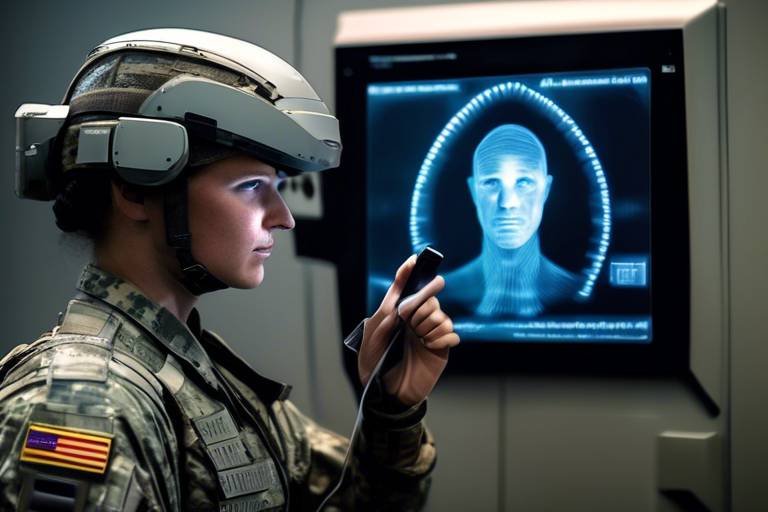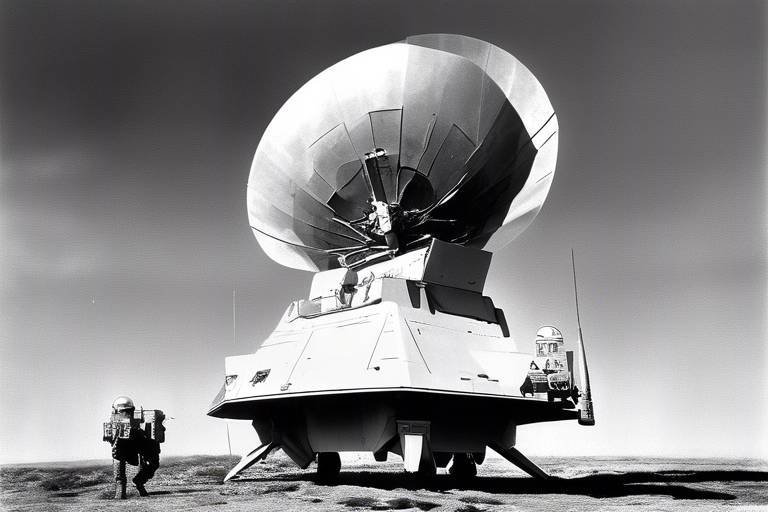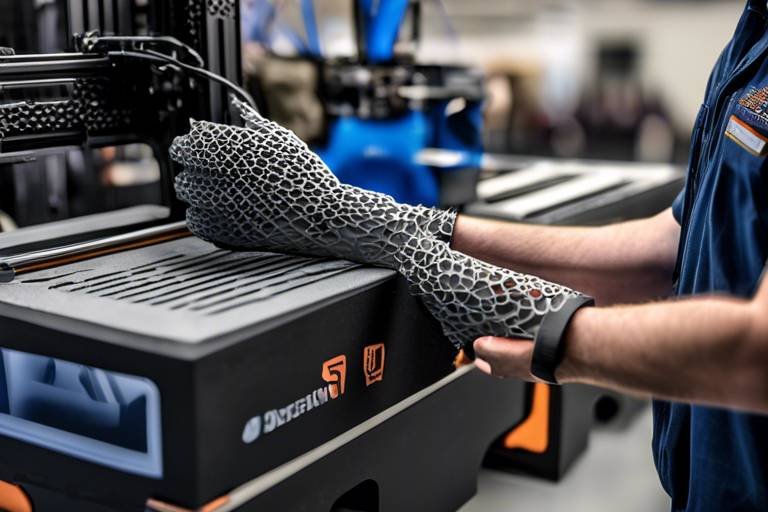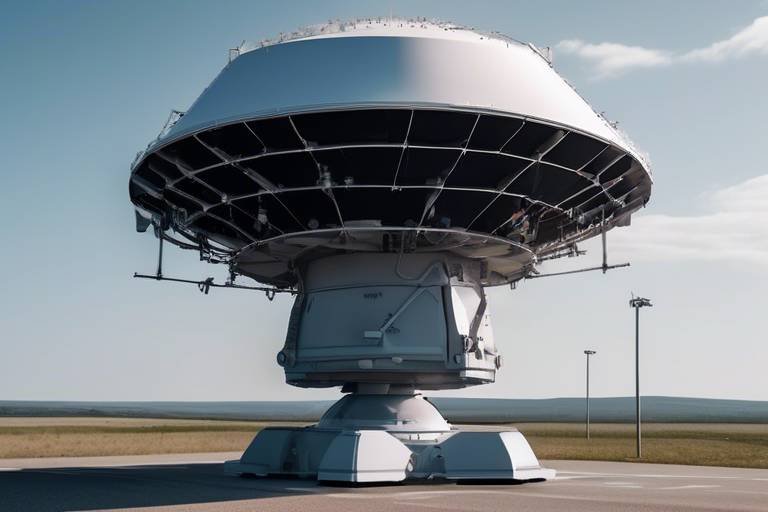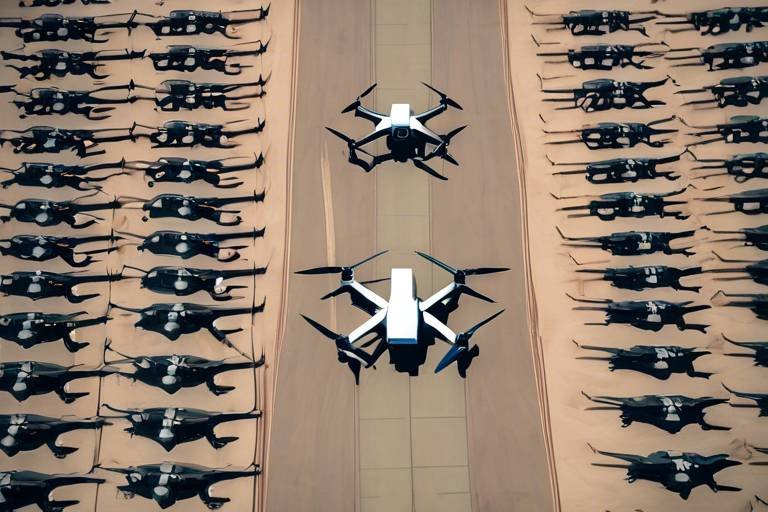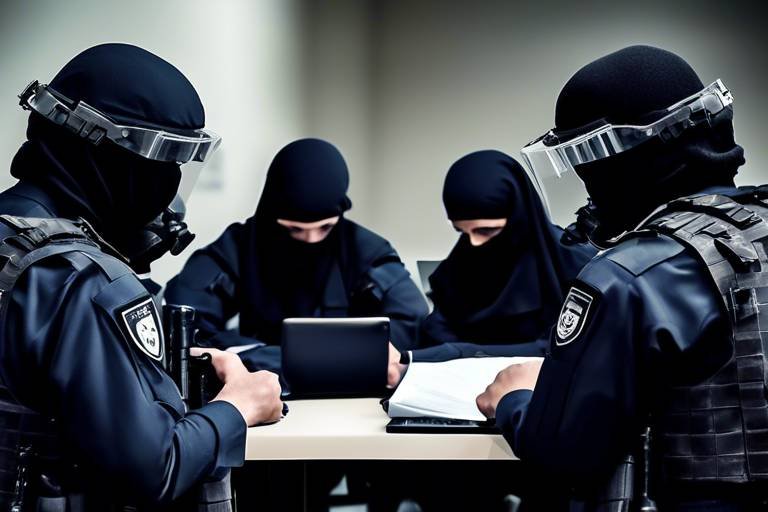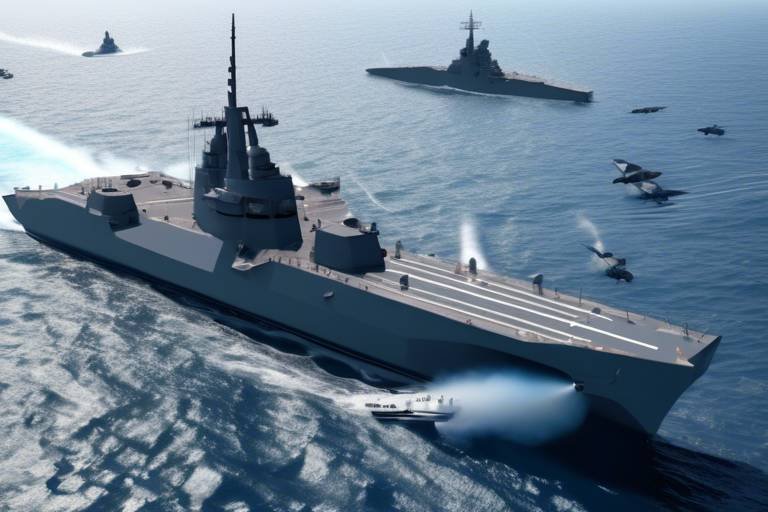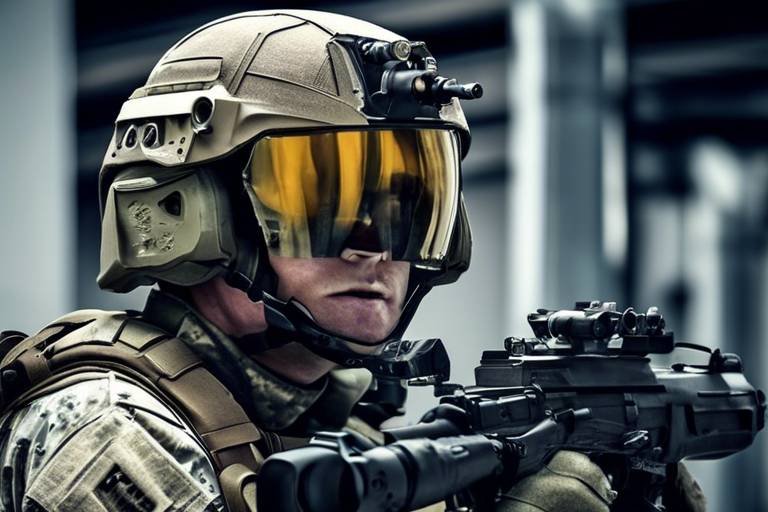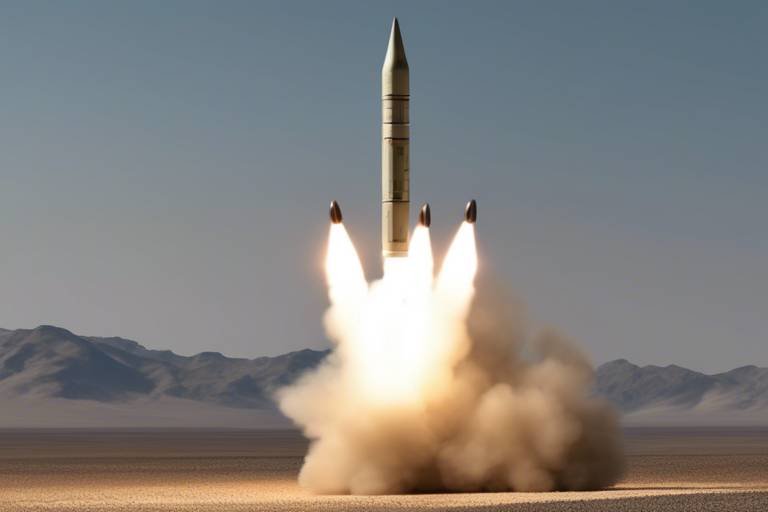How Augmented Reality Enhances Military Navigation
In today's fast-paced military landscape, the need for precise navigation and situational awareness has never been more critical. Enter Augmented Reality (AR), a game-changing technology that overlays digital information onto the physical world, providing soldiers with real-time insights that can mean the difference between success and failure on the battlefield. Imagine a soldier in the heat of combat, equipped with AR goggles that display vital information about enemy positions, terrain features, and even the health status of fellow troops—all without taking their eyes off the mission at hand. This is not science fiction; it's the transformative power of AR in military navigation.
AR technology is revolutionizing how military operations are conducted by enhancing the decision-making process and improving navigation accuracy. With AR, soldiers are no longer just relying on traditional maps and compass readings; they are now able to see a digital layer of information that helps them understand their environment better. This integration of technology into military operations not only boosts efficiency but also enhances the safety of troops operating in diverse and often dangerous terrains.
As we delve deeper into the various applications of AR in military navigation, it is essential to understand its profound impact on ground troops, airborne operations, and the future of military strategy. The potential benefits are vast, ranging from improved communication and situational awareness to advanced mission planning capabilities. So, how exactly does AR enhance military navigation? Let’s explore this innovative technology further.
At its core, AR provides a unique advantage by delivering real-time data overlays that significantly improve decision-making in military operations. Imagine being in a dense forest, where visibility is limited and every tree looks the same. With AR, soldiers can see critical information such as their location, the locations of friendly forces, and potential threats, all displayed right in their line of sight. This not only enhances situational awareness but also boosts navigation accuracy, allowing troops to maneuver effectively even in the most challenging environments.
Ground troops are among the primary beneficiaries of AR technology. The advantages are numerous and impactful:
- Improved Communication: AR facilitates seamless communication among troops by visualizing data and commands. This ensures that all members are aligned and aware of their surroundings, reducing the chances of miscommunication.
- Enhanced Target Identification: With AR, soldiers can quickly identify targets and threats, making split-second decisions that can save lives.
- Navigation in Complex Terrains: AR aids soldiers in navigating complex landscapes, providing visual cues and guidance that significantly reduce the risk of disorientation.
These benefits culminate in a more effective and responsive military force, capable of adapting to the fast-changing dynamics of modern warfare.
One of the standout features of AR systems is their ability to enhance situational awareness. By integrating critical information directly into a soldier's field of vision, AR allows for quicker reactions to changing environments and threats. For instance, if an enemy combatant is detected, AR can immediately highlight the threat, allowing soldiers to respond swiftly. This level of awareness is crucial in high-stakes situations where every second counts.
The integration of real-time data through AR applications allows soldiers to make informed decisions based on current battlefield conditions. This leads to more effective tactical responses, as troops can adapt their strategies on the fly, based on the most up-to-date information available.
AR also plays a pivotal role in enhancing communication among troops. By visualizing data and commands, AR ensures that all members of a unit are on the same page, aware of their surroundings, and prepared to act in unison. This is particularly important during complex operations where coordination is key to success.
In challenging terrains, AR proves invaluable. It provides visual cues and guidance that help soldiers navigate through difficult landscapes, significantly reducing the risk of disorientation. For example, AR can highlight safe paths through a minefield or provide directions in urban warfare scenarios, where traditional navigation methods may falter.
Airborne operations also benefit immensely from augmented reality. Pilots and crew can access vital navigation information and situational data, enhancing flight safety and mission effectiveness. The integration of AR into aviation not only improves operational efficiency but also ensures that aircrew can focus on their primary tasks without unnecessary distractions.
Heads-up displays (HUDs) equipped with AR technology offer pilots critical flight data without diverting their attention from the cockpit. This integration allows for a more streamlined flying experience, where essential information is always in view, thus improving overall flight safety.
AR tools also streamline mission planning by simulating various scenarios. This enables aircrew to visualize potential challenges and strategize effectively before deployment. By practicing in a virtual environment, crews can prepare for real-life situations, enhancing their readiness and confidence.
The future of AR in military navigation is bright, with emerging technologies set to further enhance capabilities. Innovations such as artificial intelligence integration and improved sensor technologies promise to deliver better accuracy and reliability in military operations.
The convergence of AI and AR is poised to revolutionize military navigation. Smart systems that adapt to dynamic environments and provide predictive insights for mission success will become increasingly commonplace. This fusion of technologies will empower soldiers with tools that not only react to their surroundings but also anticipate potential challenges.
While AR offers numerous benefits, challenges such as data security and technology integration must be addressed. Ensuring effective implementation and operational reliability in military settings will require ongoing research and development. However, with the right strategies in place, the military can harness the full potential of AR technology.
- What is Augmented Reality? Augmented Reality is a technology that overlays digital information onto the real world, enhancing the user's perception of their environment.
- How does AR improve military navigation? AR enhances military navigation by providing real-time data overlays, improving situational awareness, and facilitating better communication among troops.
- What are the benefits of AR for ground troops? Benefits include improved communication, enhanced target identification, and easier navigation in complex terrains.
- What role does AR play in airborne operations? AR provides critical navigation information and situational data to pilots, improving flight safety and mission effectiveness.
- What are future trends in AR military applications? Future trends include the integration of AI technologies and advancements in sensor technologies for enhanced accuracy and reliability.

The Role of Augmented Reality in Military Navigation
This article explores the transformative impact of augmented reality (AR) on military navigation, detailing its applications, benefits, and future potential in enhancing situational awareness and operational efficiency on the battlefield.
In the fast-paced and often chaotic environment of modern warfare, the ability to navigate effectively can mean the difference between mission success and failure. Augmented reality (AR) is revolutionizing military navigation by providing soldiers with real-time data overlays that enhance their situational awareness and decision-making capabilities. Imagine a soldier on the ground, equipped with AR glasses that project vital information right before their eyes. This technology allows them to see not just their immediate surroundings but also critical data such as troop positions, enemy locations, and even environmental hazards.
AR systems integrate seamlessly with existing military technologies, offering a rich tapestry of information that is crucial for effective navigation. For instance, when a soldier approaches a complex terrain, the AR system can highlight safe paths, potential threats, and points of interest, all while keeping their hands free for other tasks. This ability to visualize data in real-time is like having a personal GPS system that not only guides you but also warns you of dangers ahead.
One of the most significant advantages of AR in military navigation is its capacity to enhance situational awareness. In a battlefield scenario, information is constantly changing, and the ability to adapt quickly is essential. With AR, soldiers can receive updates on enemy movements or changes in mission objectives without having to consult a separate device. This integration of real-time data into their field of vision allows for quicker reactions and more informed decisions, ultimately leading to improved operational effectiveness.
Furthermore, AR technology fosters enhanced communication among troops. By visualizing data and commands, AR ensures that all team members are aligned and aware of their surroundings. For example, if a commander issues a directive, AR can project this information onto the heads-up displays of all soldiers in the vicinity, ensuring that everyone understands the mission's objectives and any changes that may arise. This level of connectivity is crucial in high-stakes environments where every second counts.
In summary, the role of augmented reality in military navigation cannot be overstated. It not only improves situational awareness and decision-making but also enhances communication among troops. As technology continues to advance, the potential applications of AR in military operations are bound to expand, paving the way for even more innovative solutions that can adapt to the ever-changing landscape of warfare.
Ground troops experience significant advantages from AR technology, including improved communication, enhanced target identification, and the ability to navigate complex terrains with greater ease and confidence.
AR systems enhance situational awareness by integrating critical information directly into a soldier's field of vision, allowing for quicker reactions to changing environments and threats.
The integration of real-time data through AR applications helps soldiers make informed decisions based on current battlefield conditions, leading to more effective tactical responses.
AR facilitates better communication among troops by visualizing data and commands, ensuring that all members are aligned and aware of their surroundings.
In challenging terrains, AR aids soldiers by providing visual cues and guidance, significantly reducing the risk of disorientation and improving mission success rates.
Airborne operations also benefit from augmented reality, where pilots and crew can access vital navigation information and situational data, enhancing flight safety and mission effectiveness.
Heads-up displays (HUDs) equipped with AR technology offer pilots critical flight data without diverting their attention from the cockpit, thus improving operational efficiency.
AR tools streamline mission planning by simulating various scenarios, enabling aircrew to visualize potential challenges and strategize effectively before deployment.
The future of AR in military navigation promises further advancements, with emerging technologies set to enhance capabilities, including artificial intelligence integration and improved sensor technologies for better accuracy and reliability.
The convergence of AI and AR is poised to revolutionize military navigation, enabling smarter systems that adapt to dynamic environments and provide predictive insights for mission success.
While AR offers numerous benefits, challenges such as data security and technology integration must be addressed to ensure effective implementation and operational reliability in military settings.
- What is augmented reality in military navigation? AR in military navigation refers to the use of technology that overlays digital information onto the real world, assisting soldiers in decision-making and situational awareness.
- How does AR improve situational awareness? AR enhances situational awareness by providing real-time data overlays, allowing soldiers to quickly assess their environment and respond to threats effectively.
- Can AR be used in different terrains? Yes, AR is particularly useful in complex terrains, offering visual cues and guidance to help soldiers navigate safely and efficiently.
- What are the future trends for AR in military applications? Future trends include deeper integration with AI technologies, improved sensor capabilities, and enhanced data security measures.

Benefits of AR for Ground Troops
In the rapidly evolving landscape of military operations, augmented reality (AR) stands out as a game-changer for ground troops. Imagine being in the middle of a battlefield, where every second counts, and having a technology that enhances your perception of the environment. AR does just that by providing soldiers with a layer of information right in their line of sight. This integration of digital information with the real world significantly boosts their operational effectiveness.
One of the most significant advantages of AR is its ability to enhance communication among troops. When soldiers are equipped with AR devices, they can visualize commands and situational updates in real-time. This means that instead of relying on verbal communication, which can be misinterpreted or delayed, they receive clear visual cues that everyone can see. This level of clarity ensures that all members of a unit are on the same page, which is crucial during high-stress situations.
Moreover, AR contributes to improved target identification. In the heat of battle, distinguishing between friend and foe can be a matter of life and death. AR systems can overlay vital information, such as identifying friend or foe tags or highlighting potential threats, directly onto a soldier's field of view. This capability not only speeds up the decision-making process but also reduces the likelihood of tragic mistakes.
Another critical benefit is the ability of AR to assist in navigating complex terrains. Soldiers often find themselves in environments that are not only physically challenging but also disorienting. With AR, they can receive visual cues and guidance tailored to their specific location. For instance, AR can provide a virtual map overlay, showing the best routes to take or alerting troops to obstacles ahead. This feature is especially vital in urban warfare, where buildings and structures can obstruct visibility.
To illustrate the impact of AR on ground troops, consider the following table that summarizes key benefits:
| Benefit | Description |
|---|---|
| Enhanced Communication | Visual commands and updates improve clarity and reduce miscommunication. |
| Improved Target Identification | Real-time overlays help distinguish between allies and enemies. |
| Navigation Assistance | Visual guidance helps soldiers navigate complex terrains effectively. |
In addition to these advantages, AR also fosters a sense of confidence among ground troops. When soldiers trust the technology they are using, they can focus more on their mission rather than worrying about their surroundings. This psychological edge can make a significant difference in high-stakes situations. Overall, the integration of augmented reality into military operations is not just about technology; it's about empowering soldiers with the tools they need to succeed in their missions.
- What is augmented reality (AR) in military applications? AR in military applications refers to technology that overlays digital information onto the real-world environment, enhancing situational awareness and decision-making for soldiers.
- How does AR improve communication among troops? AR improves communication by providing visual representations of commands and situational updates, ensuring clarity and alignment among all members of a unit.
- Can AR assist in navigation during combat? Yes, AR can provide visual cues and guidance, helping soldiers navigate complex terrains and reducing the risk of disorientation.
- What are the future prospects of AR in military operations? The future of AR in military operations includes advancements such as AI integration and improved sensor technologies, enhancing accuracy and reliability.

Improved Situational Awareness
In the high-stakes world of military operations, situational awareness is not just a buzzword; it's a matter of life and death. Augmented reality (AR) transforms the battlefield into a more navigable space by integrating critical information directly into a soldier's field of vision. Imagine a scenario where a soldier is navigating through dense urban terrain, surrounded by potential threats. With AR, they can see real-time overlays of enemy positions, friendly units, and even environmental hazards, all without taking their eyes off the mission at hand. This level of awareness allows for quicker reactions to changing situations, reducing the chances of ambush or miscommunication.
One of the most remarkable features of AR systems is their ability to provide real-time data integration. This means that as conditions on the battlefield change—whether it’s the arrival of reinforcements, a sudden enemy attack, or shifting weather patterns—soldiers receive immediate updates. For example, if a unit encounters unexpected resistance, AR can instantly display alternative routes or tactical options, enabling soldiers to adapt their strategies on-the-fly. This not only enhances their ability to respond but also increases their confidence, knowing they have the most accurate information at their fingertips.
Moreover, AR enhances communication among troops. Imagine being in a chaotic environment where verbal communication is drowned out by the sounds of gunfire and explosions. AR can visualize commands and data, projecting them into the soldier's line of sight. This ensures that all team members are aligned and aware of their surroundings, minimizing the risk of friendly fire and maximizing operational efficiency. The ability to see important information at a glance—like the location of allies or the status of equipment—can be the difference between success and failure in a mission.
In summary, augmented reality elevates situational awareness to unprecedented levels. By providing real-time data integration and enhancing communication among troops, AR empowers soldiers to make informed decisions swiftly. It’s like having a digital map that not only shows where you are but also highlights where you need to go and warns you of potential dangers along the way. As AR technology continues to evolve, its impact on military navigation will only become more profound, paving the way for safer and more effective operations.
- What is augmented reality?
Augmented reality (AR) is a technology that overlays digital information—such as images, sounds, or text—onto the real world, enhancing the user's perception of their environment. - How does AR improve military navigation?
AR improves military navigation by providing real-time data overlays, enhancing situational awareness, and improving communication among troops, which leads to better decision-making on the battlefield. - What are the benefits of AR for ground troops?
Ground troops benefit from AR through improved communication, enhanced target identification, and better navigation in complex terrains, allowing for greater operational efficiency and safety. - Are there any challenges to implementing AR in the military?
Yes, challenges such as data security, technology integration, and the need for reliable hardware and software must be addressed to ensure effective implementation of AR in military settings.

Real-Time Data Integration
Imagine being a soldier on the battlefield, where every second counts and the stakes are incredibly high. In such scenarios, through augmented reality (AR) can make the difference between success and failure. AR systems provide soldiers with vital information, seamlessly overlaying it onto their field of vision. This integration allows troops to access a wealth of data, including enemy positions, terrain details, and weather conditions, all while remaining fully engaged in their immediate environment.
One of the most remarkable aspects of real-time data integration is its ability to transform how soldiers make decisions. Instead of relying solely on maps or verbal commands, they can visualize critical information right in front of them. For instance, if a unit is navigating through a dense forest, AR can highlight the safest paths, potential ambush points, and even the locations of friendly forces. This capability not only enhances situational awareness but also allows for quicker, more informed decision-making.
Moreover, the integration of real-time data can significantly reduce the cognitive load on soldiers. When information is presented visually and contextually, it becomes easier to process and act upon. In high-pressure situations, this means that soldiers can focus on their objectives rather than getting bogged down by data overload. The result? A more agile and responsive military force that can adapt to rapidly changing conditions on the ground.
To illustrate the impact of real-time data integration, consider the following table that outlines key benefits:
| Benefit | Description |
|---|---|
| Enhanced Decision-Making | Access to real-time data allows for quicker and more informed tactical decisions. |
| Increased Safety | Visual cues help soldiers navigate hazardous environments, reducing the risk of accidents. |
| Improved Coordination | Real-time information sharing enhances teamwork and alignment among units. |
In addition to these benefits, real-time data integration fosters a culture of collaboration among troops. With AR systems, information can be shared instantly across units, ensuring that everyone is on the same page. This is particularly crucial during joint operations, where multiple branches of the military may be working together. The ability to visualize and share data in real-time enhances operational efficiency and effectiveness, ultimately leading to mission success.
As we look to the future, the potential for real-time data integration in military operations is vast. With advancements in technology, we can expect even more sophisticated AR systems that provide deeper insights and predictive analytics. This evolution will empower soldiers to not only react to situations but also anticipate challenges before they arise, further solidifying the role of AR as a game-changer in military navigation.
- What is augmented reality in military navigation?
Augmented reality (AR) in military navigation refers to the use of technology that overlays digital information onto the real world, providing soldiers with real-time data for enhanced decision-making and situational awareness. - How does real-time data integration improve military operations?
Real-time data integration allows soldiers to access critical information instantly, enhancing their ability to make informed decisions, improving coordination among units, and increasing overall mission success rates. - What are some challenges associated with implementing AR in the military?
Challenges include data security concerns, the need for reliable technology integration, and ensuring that soldiers are properly trained to use AR systems effectively. - What is the future of AR in military applications?
The future of AR in military applications looks promising, with advancements in AI and sensor technologies expected to enhance capabilities, improve accuracy, and provide predictive insights for mission success.

Enhanced Communication
In the fast-paced world of military operations, effective communication can mean the difference between mission success and failure. Augmented Reality (AR) plays a crucial role in enhancing communication among ground troops. By visualizing data and commands directly in the soldier's field of view, AR ensures that every team member is synchronized and fully aware of their surroundings. Imagine a battlefield where information flows seamlessly, where every soldier has access to the same situational updates in real-time. This is the promise of AR technology.
One of the standout features of AR is its ability to integrate various data sources into a single, coherent visual display. For instance, when a soldier receives a command, they can see not only the order but also the relevant maps, troop movements, and potential threats, all layered onto their environment. This integration is not just about presenting information; it's about transforming how soldiers interact with their surroundings. They can quickly assess the situation, make informed decisions, and communicate effectively with their teammates.
Moreover, AR enhances communication through the use of visual markers. These markers can indicate points of interest, enemy locations, or safe paths to follow. When a soldier sees a visual cue in their AR headset, they can relay that information to their team without the need for lengthy verbal communication. This is especially critical in high-stress scenarios where time is of the essence. By reducing the cognitive load on soldiers, AR allows them to focus on their immediate tasks rather than getting bogged down by communication hurdles.
Additionally, AR can facilitate remote collaboration. With AR technology, commanders can provide real-time guidance to troops in the field, even from a distance. This capability is akin to having a tactical advisor right there on the ground, offering insights and directions that can significantly enhance operational efficiency. For example, if a squad encounters unexpected resistance, they can instantly share their view with a commander who can advise on the best course of action based on a broader perspective of the battlefield.
In conclusion, the enhanced communication capabilities provided by AR not only improve the immediate operational effectiveness of military units but also foster a culture of collaboration and strategic thinking. As technology continues to evolve, the potential for AR to reshape communication in military settings is immense, paving the way for a more connected and responsive force.
- What is Augmented Reality (AR) in military applications?
AR in military applications refers to the integration of digital information with the physical environment, enhancing situational awareness and decision-making for soldiers. - How does AR improve communication among troops?
AR improves communication by providing real-time data overlays, visual cues, and remote collaboration capabilities, allowing soldiers to share critical information instantly. - Can AR be used in all types of military operations?
Yes, AR can be utilized in various military operations, including ground, airborne, and naval missions, enhancing navigation and situational awareness across the board. - What are some challenges of implementing AR in the military?
Challenges include data security, technology integration, and ensuring that soldiers are adequately trained to use AR systems effectively.

Navigation in Complex Environments
In the battlefield, navigating through complex environments can feel like trying to find your way through a dense fog—confusing and disorienting. This is where Augmented Reality (AR) steps in as a game-changer. By providing soldiers with real-time visual cues and overlays, AR transforms the way troops interact with their surroundings. Imagine being able to see a digital map projected right on your visor, highlighting safe paths and potential hazards. This technology not only enhances navigation but also boosts confidence, allowing soldiers to focus on their mission rather than getting lost.
One of the key advantages of AR in complex terrains is its ability to integrate various data sources into a cohesive display. For instance, soldiers can receive information about enemy positions, weather conditions, and terrain features all in one view. This integration can be crucial during operations in urban environments, dense forests, or mountainous regions where traditional navigation methods may fall short. The seamless flow of information helps reduce cognitive load, allowing troops to make quicker, more informed decisions.
Moreover, AR systems can adapt to different environments, providing tailored navigation assistance. For example, in a dense jungle, AR can highlight paths through the foliage, while in urban settings, it can display building layouts and potential escape routes. This adaptability is vital for mission success, as it minimizes the risk of disorientation and enhances situational awareness.
To illustrate the impact of AR on navigation, consider the following table that outlines key features of AR systems used in complex environments:
| Feature | Description |
|---|---|
| Real-Time Mapping | Displays current locations and routes on a digital map overlay. |
| Obstacle Detection | Identifies and highlights potential obstacles in the soldier's path. |
| Environmental Integration | Adapts navigation cues based on specific terrain features. |
| Data Fusion | Combines information from various sensors for comprehensive situational awareness. |
As we look to the future, the potential for AR in military navigation continues to expand. The integration of advanced sensors and AI technology will further enhance these systems, making them even more reliable and effective. With AR, soldiers can navigate through the most challenging environments with greater ease, ensuring that they remain focused on their objectives rather than the obstacles in their path.
- What is Augmented Reality in military navigation?
Augmented Reality (AR) in military navigation refers to the use of technology to overlay digital information onto the real-world environment, enhancing situational awareness and decision-making for soldiers. - How does AR improve navigation for ground troops?
AR improves navigation by providing real-time data overlays, visual cues, and obstacle detection, allowing soldiers to navigate complex terrains more confidently. - Can AR be used in all types of environments?
Yes, AR can adapt to various environments, including urban, forested, and mountainous areas, providing tailored navigation assistance based on specific challenges. - What are the future trends for AR in military applications?
The future of AR in military applications includes advancements in AI integration, improved sensor technologies, and enhanced data security measures to ensure reliable and effective use.

AR Technology in Airborne Operations
In the rapidly evolving landscape of military aviation, augmented reality (AR) is paving the way for a new era of operational excellence. Imagine a pilot soaring through the skies, navigating complex airspace, while critical information is seamlessly integrated into their field of vision. This is not science fiction; it’s the reality of AR technology in airborne operations. By providing real-time data overlays, AR significantly enhances situational awareness, ensuring that pilots can focus on their missions without the distraction of traditional instruments.
One of the standout features of AR in aviation is the use of Heads-Up Displays (HUDs). These advanced systems project vital flight data—such as altitude, speed, and navigation information—directly onto the cockpit windshield. This means pilots can keep their eyes on the horizon while still accessing essential information, which is crucial during high-stakes operations. The benefits of HUDs are manifold:
| Benefit | Description |
|---|---|
| Increased Focus | Pilots maintain visual contact with the environment, reducing the risk of accidents. |
| Reduced Workload | Information is presented in a more intuitive manner, allowing pilots to make quicker decisions. |
| Enhanced Safety | Real-time data helps in avoiding potential hazards in the airspace. |
Moreover, AR technology plays a pivotal role in mission planning and execution. Before embarking on a mission, aircrew can utilize AR tools to simulate various scenarios. This capability allows them to visualize potential challenges, assess risks, and strategize effectively. For instance, they can simulate different weather conditions, enemy engagements, or equipment failures, enabling them to prepare for a variety of outcomes. This level of preparedness is akin to a chess player anticipating their opponent’s moves—foreseeing challenges before they arise.
But the advantages of AR don’t stop there. As operational environments become increasingly complex, the integration of AR with other technologies, such as artificial intelligence (AI), stands to revolutionize airborne operations even further. AI can analyze vast amounts of data and provide predictive insights, allowing pilots to make informed decisions in real-time. This synergy between AR and AI is like having a co-pilot that never tires, always ready to assist with insights and recommendations.
In summary, AR technology is not just a tool; it’s a game changer for airborne operations. By enhancing situational awareness, streamlining mission planning, and integrating with AI, AR equips pilots with the tools they need to perform at their best. As we look to the future, the potential for AR in military aviation is boundless, promising safer and more efficient operations in the skies.
- What is augmented reality (AR) in military aviation?
AR in military aviation refers to technology that overlays digital information onto a pilot's field of vision, enhancing situational awareness and operational efficiency. - How does AR improve pilot safety?
By providing real-time data directly in the pilot's line of sight, AR reduces distractions and allows for quicker decision-making, ultimately enhancing flight safety. - What role does AI play in AR technology?
AI enhances AR systems by analyzing data and providing predictive insights, which helps pilots adapt to dynamic environments and improve mission outcomes. - Are there any challenges associated with implementing AR in military aviation?
Yes, challenges include data security concerns and the need for effective integration with existing systems to ensure reliability and operational effectiveness.

Heads-Up Displays in Aircraft
Heads-Up Displays (HUDs) in aircraft represent a significant leap forward in aviation technology, merging the physical and digital worlds to enhance pilot performance and safety. Imagine flying through turbulent skies while simultaneously having critical flight data projected right in front of your eyes. This is precisely what HUDs offer—an incredible interface that allows pilots to maintain their focus on the horizon while accessing essential information without the need to look down at traditional instruments. It’s like having a co-pilot who whispers vital stats directly into your ear, allowing you to keep your eyes on the prize—the sky ahead.
One of the most impressive features of HUDs is their ability to display a variety of information, including altitude, speed, navigation data, and even targeting information in military aircraft. This comprehensive data overlay not only enhances situational awareness but also significantly reduces the cognitive load on pilots, allowing them to make quicker, more informed decisions. In the heat of battle or during complex maneuvers, this can be the difference between success and failure.
Moreover, the integration of augmented reality into HUD technology takes this a step further. With AR, pilots can see real-time overlays of their environment, including obstacles, other aircraft, and even weather patterns. For instance, if a pilot is navigating through a storm, AR can highlight the safest flight path, effectively turning chaos into clarity. This level of situational awareness is invaluable, especially in high-stakes military operations where every second counts.
To illustrate the benefits of HUDs, consider the following table that compares traditional cockpit displays with HUD technology:
| Feature | Traditional Cockpit Displays | Heads-Up Displays |
|---|---|---|
| Data Visibility | Requires looking down | Projected in pilot's line of sight |
| Situational Awareness | Limited to instrument readings | Enhanced with real-time overlays |
| Cognitive Load | Higher due to frequent head movement | Lower, allowing focus on flying |
| Response Time | Slower due to distraction | Faster, enabling quicker decisions |
As we look to the future, the evolution of HUD technology is set to continue. Innovations such as artificial intelligence integration could further enhance these systems, providing predictive analytics that help pilots anticipate challenges before they arise. Imagine a HUD that not only displays current conditions but also suggests proactive maneuvers based on historical data and real-time analysis. The possibilities are exciting and could redefine the way we think about flight safety and efficiency.
- What is a Heads-Up Display (HUD)? A HUD is a display system that projects crucial flight information directly in the pilot's line of sight, allowing for better situational awareness without diverting attention from the flying environment.
- How does augmented reality enhance HUDs? Augmented reality adds real-time overlays of critical data, such as navigation paths and obstacle warnings, improving decision-making and situational awareness.
- Are HUDs only used in military aircraft? No, HUDs are used in both military and civilian aircraft to improve safety and operational efficiency.
- What are the potential future advancements for HUD technology? Future advancements may include AI integration for predictive analytics, improved sensor technologies, and enhanced data visualization capabilities.

Mission Planning and Execution
In the fast-paced world of military operations, are critical components that can determine the success or failure of a mission. Augmented reality (AR) technology plays an essential role in this process by providing a dynamic simulation environment that allows military personnel to visualize scenarios before they unfold in real life. Imagine being able to walk through a virtual version of the battlefield, identifying potential obstacles and threats, all while strategizing the best course of action. This is precisely what AR offers, making it an invaluable tool for modern military forces.
AR tools enable soldiers and aircrew to engage in realistic simulations that replicate various mission scenarios. By using these simulations, teams can practice their responses to different situations, from enemy encounters to environmental challenges. This proactive approach not only enhances preparedness but also fosters teamwork as soldiers learn to communicate and collaborate effectively under pressure.
Furthermore, AR applications can integrate data from multiple sources, such as satellite imagery and real-time intelligence reports, to create a comprehensive operational picture. This integration allows military planners to assess the battlefield conditions accurately and make informed decisions. For instance, they can visualize troop movements, identify high-risk zones, and plan logistical routes, all within the AR interface. This capability significantly reduces the time needed for planning and increases the likelihood of mission success.
To illustrate the impact of AR on mission planning, consider the following table that outlines key advantages:
| Advantage | Description |
|---|---|
| Enhanced Visualization | AR provides a 3D view of the battlefield, allowing for better understanding of terrain and obstacles. |
| Real-Time Data Access | Access to live data feeds ensures that planners have the most current information at their fingertips. |
| Improved Coordination | AR facilitates seamless communication among team members, ensuring everyone is on the same page. |
| Scenario Simulation | Teams can rehearse multiple scenarios, preparing them for unexpected developments during actual missions. |
As military operations become more complex, the integration of AR into mission planning and execution will continue to evolve. The technology is not just about enhancing current capabilities; it’s about rethinking how missions are planned and executed from the ground up. With AR, the military can anticipate challenges and adapt strategies in real time, which is crucial in today’s unpredictable combat environments.
- How does augmented reality improve military training?
AR enhances training by providing immersive simulations that replicate real-world scenarios, allowing soldiers to practice and refine their skills. - What are the limitations of AR in military applications?
Some limitations include potential data security issues and the need for robust technology infrastructure to support AR systems. - Can AR be used in non-combat military operations?
Yes, AR can be beneficial in logistics, maintenance, and support roles, improving efficiency and situational awareness across various military operations.

Future Trends in AR Military Applications
The future of augmented reality (AR) in military applications is not just a glimpse of what could be; it's an unfolding reality that promises to revolutionize how armed forces operate. As technology continues to advance at a breakneck pace, we can expect AR to become an integral part of military strategy and operations. Imagine soldiers equipped with AR glasses that overlay essential information directly onto their field of vision, transforming the way they perceive and interact with their environment. This is not science fiction; this is the future that is rapidly approaching.
One of the most exciting trends is the integration of artificial intelligence (AI) with AR technologies. Picture a scenario where AI algorithms analyze real-time data from the battlefield, predicting potential threats and suggesting optimal tactical maneuvers. This fusion of technologies will not only enhance situational awareness but also enable soldiers to make faster, more informed decisions. The ability to adapt to dynamic environments is crucial in military operations, and AI-powered AR systems are set to provide that edge.
Moreover, the development of advanced sensor technologies will play a significant role in improving AR applications. These sensors will gather data from various sources, including GPS, drones, and satellites, to create a comprehensive battlefield picture. By integrating this data into AR systems, military personnel will have access to unparalleled situational awareness. For instance, a soldier navigating through dense urban terrain could receive real-time updates about enemy locations, friendly forces, and even environmental hazards, all displayed seamlessly through their AR device.
However, as we embrace these advancements, we must also consider the potential challenges that come with them. Data security is a significant concern; as military operations become increasingly reliant on digital technologies, safeguarding sensitive information becomes paramount. Ensuring that AR systems are secure from cyber threats will be essential for maintaining operational integrity. Additionally, the integration of AR into existing military frameworks may face hurdles, requiring extensive training and adaptation among personnel.
To address these challenges, military organizations are likely to invest in robust cybersecurity measures and comprehensive training programs. The goal will be to create a seamless transition into this new era of warfare, where technology enhances human capabilities rather than complicates them. As we stand on the brink of this technological evolution, the potential for AR in military applications is immense, promising to enhance not only operational efficiency but also the safety and effectiveness of our armed forces.
- What is augmented reality in military applications?
Augmented reality in military applications refers to the use of technology to overlay digital information onto the physical environment, enhancing situational awareness and decision-making for military personnel.
- How does AI integration enhance AR in the military?
AI integration allows AR systems to analyze real-time data, predict threats, and suggest tactical maneuvers, thus improving decision-making speed and accuracy on the battlefield.
- What are the primary challenges of implementing AR in military operations?
Key challenges include data security concerns, the need for extensive training, and the integration of AR technologies into existing military frameworks.
- What future advancements can we expect in AR military applications?
Future advancements may include improved sensor technologies, more sophisticated AI algorithms, and enhanced data security measures to ensure effective and safe implementation of AR in military settings.

Integration with AI Technologies
The convergence of Artificial Intelligence (AI) and Augmented Reality (AR) is set to create a paradigm shift in military navigation. Imagine a world where soldiers are not just equipped with AR glasses, but also with intelligent systems that can predict threats and provide real-time solutions based on the battlefield dynamics. This integration is akin to having a personal assistant that not only helps you navigate through a busy city but also alerts you to potential hazards along the way. The synergy between AI and AR can enhance decision-making processes, enabling troops to react swiftly and effectively to unpredictable situations.
One of the most significant advantages of integrating AI with AR is the capability for predictive analytics. By analyzing vast amounts of data from various sources—such as satellite imagery, weather reports, and troop movements—AI can offer insights that were previously unimaginable. For instance, if a unit is approaching a potentially hostile area, AI can assess the likelihood of enemy presence and suggest alternative routes, thereby enhancing the safety and success of the mission.
Additionally, AI can assist in target identification by processing visual data from the battlefield. When integrated with AR systems, this technology can highlight potential threats in real-time, allowing soldiers to maintain situational awareness without being overwhelmed by information. Think of it as having a digital co-pilot that helps filter out noise and focus on what truly matters.
However, the integration of AI technologies into military navigation does not come without its challenges. Issues such as data security, system reliability, and the need for robust training programs for personnel must be addressed to ensure that these technologies are used effectively. As military operations become increasingly reliant on technology, the importance of securing sensitive data cannot be overstated.
To ensure successful integration, military organizations must adopt a comprehensive approach that includes:
- Rigorous testing of AI systems in various operational scenarios.
- Development of training programs that emphasize both AR and AI functionalities.
- Implementation of stringent data protection protocols to safeguard against cyber threats.
In conclusion, the integration of AI and AR technologies is not just a futuristic concept; it is a reality that is quickly taking shape. As these technologies continue to evolve, the potential for enhanced military navigation becomes more profound, promising a future where soldiers are equipped with the best tools to ensure their safety and mission success.
Q: How does AI improve AR in military navigation?
A: AI enhances AR by providing predictive analytics, improving target identification, and offering real-time solutions based on battlefield data.
Q: What are the main challenges of integrating AI with AR?
A: Key challenges include data security, system reliability, and the need for comprehensive training programs to ensure effective use of the technologies.
Q: Can AR and AI technologies be used in civilian applications?
A: Yes, the integration of AR and AI has potential applications in various civilian sectors, including healthcare, logistics, and urban planning.

Potential Challenges and Solutions
As we delve into the exciting world of augmented reality (AR) in military navigation, it's essential to recognize that with great innovation comes significant challenges. While AR has the potential to revolutionize how soldiers navigate and make decisions on the battlefield, several hurdles must be addressed to ensure its successful implementation.
One of the most pressing challenges is data security. In a military context, sensitive information is constantly at risk of being intercepted or hacked. Imagine a soldier relying on AR for critical navigation data only to find that an enemy has compromised the system. To combat this, military organizations must invest in robust cybersecurity measures, including encryption and secure communication protocols, to protect data integrity and confidentiality.
Another challenge lies in technology integration. Many military units still rely on traditional navigation methods and systems. Transitioning to AR requires extensive training and a shift in mindset. It's not just about providing soldiers with new gadgets; it's about ensuring they understand how to use these tools effectively. Comprehensive training programs must be developed, focusing on both the technical aspects of AR systems and the tactical advantages they offer. This will help soldiers feel comfortable and confident in using AR during missions.
Furthermore, there are concerns regarding the reliability of AR systems in various environmental conditions. Imagine navigating through a dense forest or an urban area with poor visibility; if the AR system fails, it could lead to disastrous outcomes. To tackle this, developers need to create AR systems that are resilient and can function seamlessly across different terrains and weather conditions. Rigorous testing and field trials will be crucial in identifying and addressing these vulnerabilities before deployment.
Lastly, there is the issue of user interface design. For AR to be effective, the information displayed must be intuitive and easy to interpret. A cluttered or complicated interface can overwhelm soldiers, leading to confusion in high-stress situations. Therefore, designers should prioritize user experience, ensuring that critical data is presented clearly and concisely. This can be achieved through iterative design processes that involve feedback from actual users—soldiers who will be using the technology in real-life scenarios.
In summary, while the integration of augmented reality in military navigation presents exciting opportunities, addressing the potential challenges is vital for its success. By focusing on data security, technology integration, system reliability, and user interface design, military organizations can harness the full potential of AR, ultimately enhancing operational efficiency and situational awareness on the battlefield.
- What is augmented reality (AR) in military navigation?
AR in military navigation refers to the use of technology that overlays digital information onto the physical world, providing soldiers with real-time data to enhance their situational awareness and decision-making capabilities. - How does AR improve situational awareness?
AR improves situational awareness by integrating critical information directly into a soldier's field of vision, allowing them to react more quickly to changing environments and threats. - What are the main challenges of implementing AR in the military?
The main challenges include data security, technology integration, system reliability in various environments, and user interface design. - How can data security be ensured in AR systems?
Data security can be ensured through robust cybersecurity measures such as encryption, secure communication protocols, and regular system updates to protect against vulnerabilities. - Why is training important for AR implementation?
Training is crucial because it helps soldiers understand how to effectively use AR tools, ensuring they can leverage the technology's advantages in real-world situations.
Frequently Asked Questions
- What is augmented reality (AR) in military navigation?
Augmented reality (AR) in military navigation refers to the technology that overlays digital information onto the real-world environment. This allows soldiers to see critical data, such as maps, enemy positions, and tactical information, directly in their field of vision, enhancing their situational awareness and decision-making capabilities.
- How does AR improve situational awareness for ground troops?
AR enhances situational awareness by providing real-time data overlays that integrate vital information into a soldier's view. This means they can react faster to changes in their environment, identify threats more efficiently, and make informed decisions without having to divert their attention away from the battlefield.
- What are the key benefits of AR for soldiers in the field?
The key benefits of AR for soldiers include:
- Improved communication and coordination among troops.
- Enhanced target identification and engagement.
- Better navigation through complex terrains, reducing disorientation.
- How does AR assist in airborne military operations?
In airborne operations, AR provides pilots with critical navigation information and situational data through heads-up displays (HUDs). This technology allows them to access essential flight data without taking their eyes off the cockpit, thus improving flight safety and mission effectiveness.
- What future trends can we expect in AR military applications?
The future of AR in military navigation is promising, with advancements likely to include the integration of artificial intelligence (AI) for smarter systems that adapt to dynamic environments. Additionally, improved sensor technologies will enhance accuracy and reliability in various military applications.
- What challenges does AR face in military settings?
While AR offers numerous benefits, it also faces challenges such as data security concerns and the complexities of technology integration. Addressing these issues is crucial to ensure effective implementation and operational reliability in military environments.



